Leadership and Management: British Steel Case Study and Analysis
VerifiedAdded on 2022/12/28
|12
|3426
|76
Report
AI Summary
This report provides an executive summary and in-depth analysis of leadership and management principles, focusing on the context of operations management within an organization. The report begins by defining and comparing the roles and characteristics of leaders and managers, highlighting their distinct responsibilities and contributions. It then examines how these roles apply in different situational contexts, using British Steel as a case study. The report explores various leadership theories, including situational, system, and contingency leadership, and explains key approaches to operations management, such as lean production, just-in-time, and total quality management. It emphasizes the importance of operations management in achieving business objectives, particularly customer satisfaction and efficient resource allocation. Finally, the report assesses factors within the business environment that impact operational management and decision-making by leaders and managers. The report concludes with a comprehensive overview of the findings and implications for effective leadership and management practices.
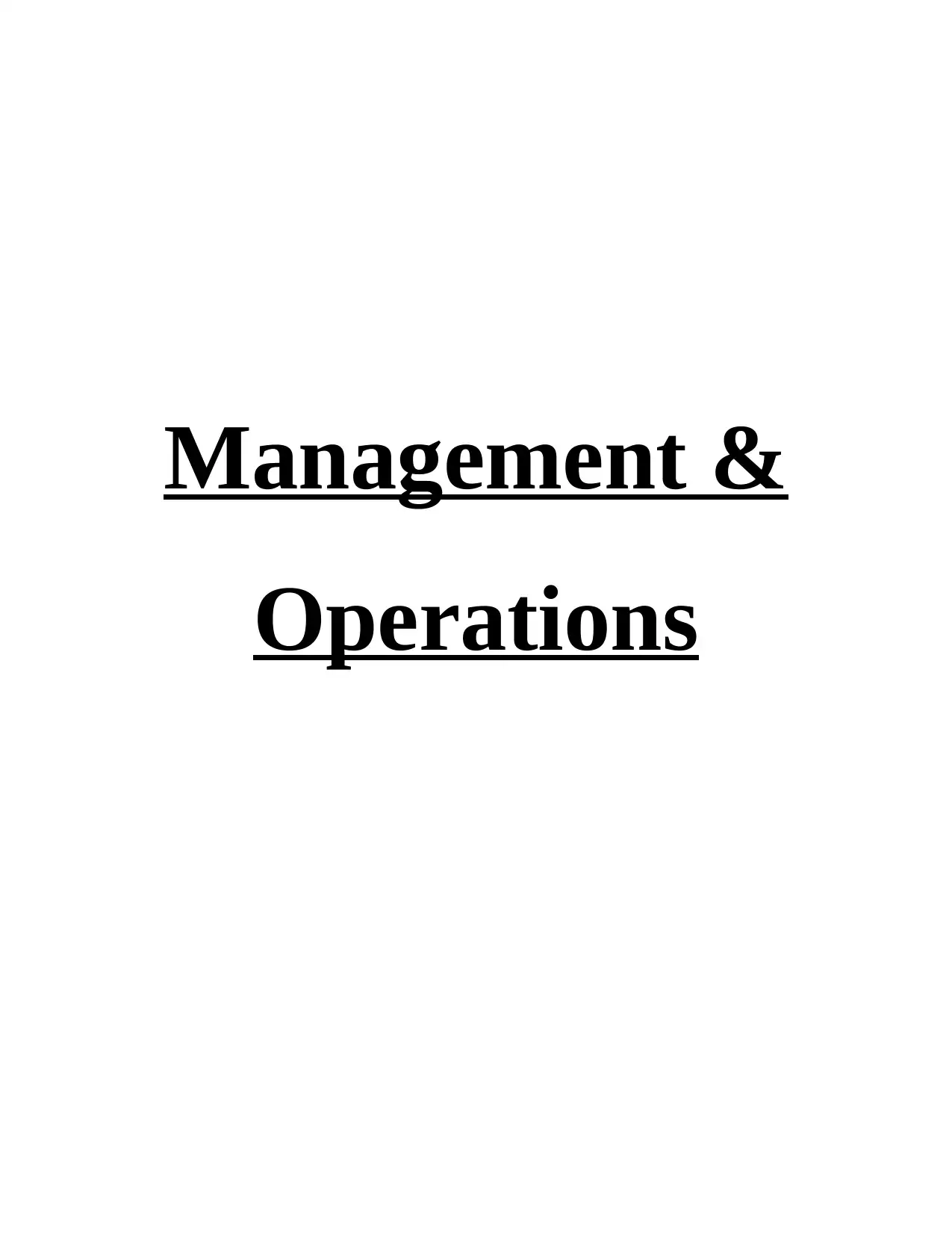
Management &
Operations
Operations
Paraphrase This Document
Need a fresh take? Get an instant paraphrase of this document with our AI Paraphraser
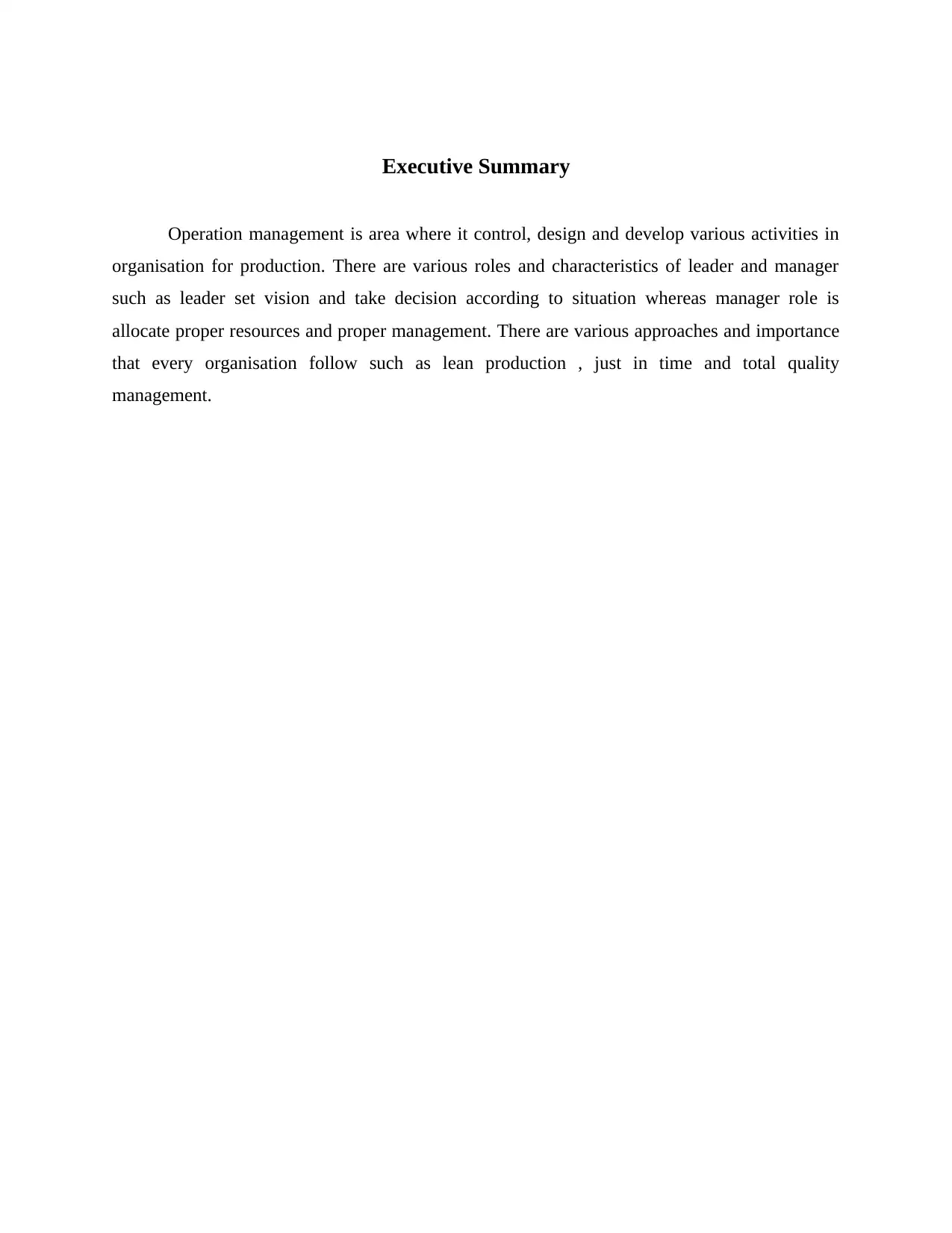
Executive Summary
Operation management is area where it control, design and develop various activities in
organisation for production. There are various roles and characteristics of leader and manager
such as leader set vision and take decision according to situation whereas manager role is
allocate proper resources and proper management. There are various approaches and importance
that every organisation follow such as lean production , just in time and total quality
management.
Operation management is area where it control, design and develop various activities in
organisation for production. There are various roles and characteristics of leader and manager
such as leader set vision and take decision according to situation whereas manager role is
allocate proper resources and proper management. There are various approaches and importance
that every organisation follow such as lean production , just in time and total quality
management.
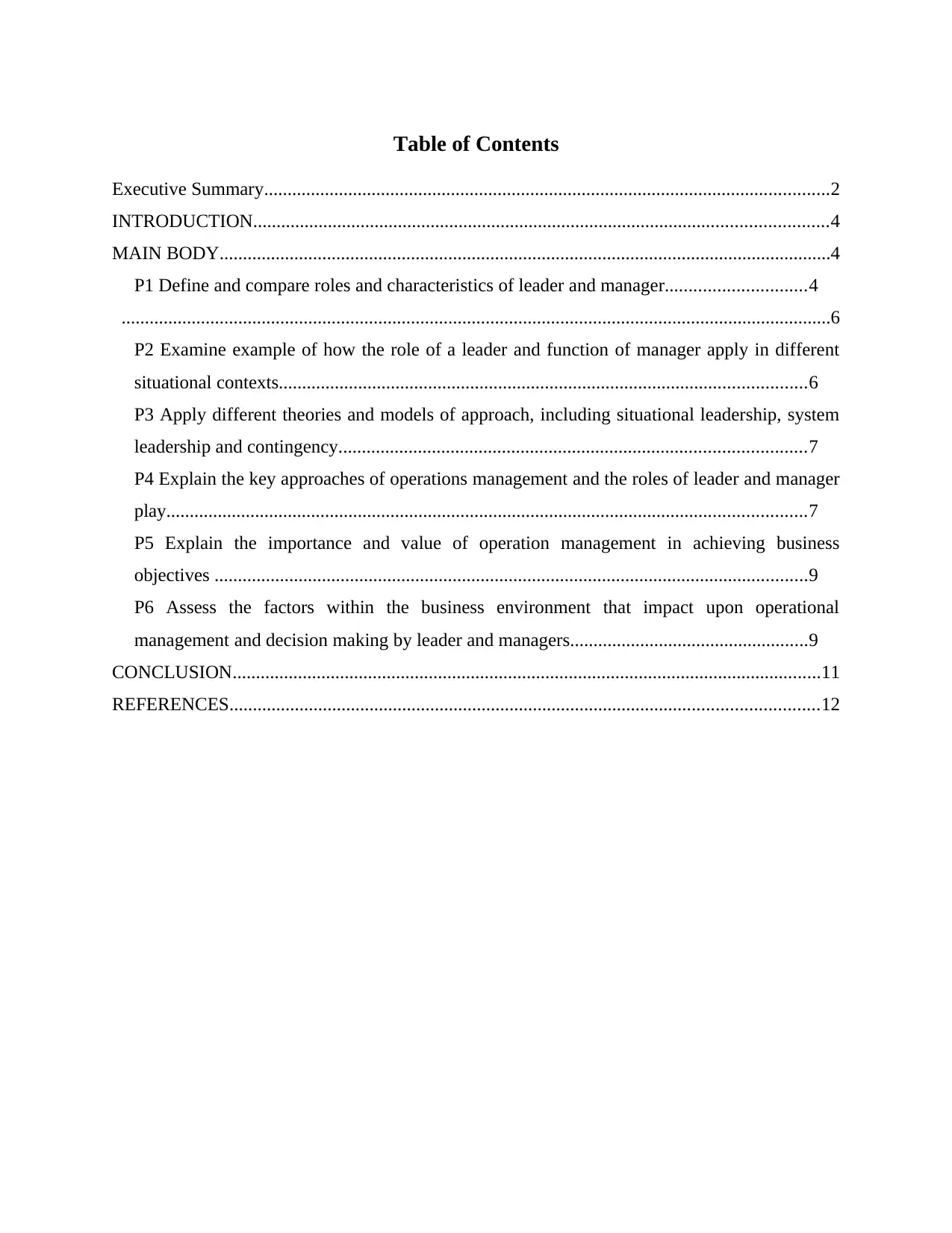
Table of Contents
Executive Summary.........................................................................................................................2
INTRODUCTION...........................................................................................................................4
MAIN BODY...................................................................................................................................4
P1 Define and compare roles and characteristics of leader and manager..............................4
........................................................................................................................................................6
P2 Examine example of how the role of a leader and function of manager apply in different
situational contexts.................................................................................................................6
P3 Apply different theories and models of approach, including situational leadership, system
leadership and contingency....................................................................................................7
P4 Explain the key approaches of operations management and the roles of leader and manager
play.........................................................................................................................................7
P5 Explain the importance and value of operation management in achieving business
objectives ...............................................................................................................................9
P6 Assess the factors within the business environment that impact upon operational
management and decision making by leader and managers...................................................9
CONCLUSION..............................................................................................................................11
REFERENCES..............................................................................................................................12
Executive Summary.........................................................................................................................2
INTRODUCTION...........................................................................................................................4
MAIN BODY...................................................................................................................................4
P1 Define and compare roles and characteristics of leader and manager..............................4
........................................................................................................................................................6
P2 Examine example of how the role of a leader and function of manager apply in different
situational contexts.................................................................................................................6
P3 Apply different theories and models of approach, including situational leadership, system
leadership and contingency....................................................................................................7
P4 Explain the key approaches of operations management and the roles of leader and manager
play.........................................................................................................................................7
P5 Explain the importance and value of operation management in achieving business
objectives ...............................................................................................................................9
P6 Assess the factors within the business environment that impact upon operational
management and decision making by leader and managers...................................................9
CONCLUSION..............................................................................................................................11
REFERENCES..............................................................................................................................12
⊘ This is a preview!⊘
Do you want full access?
Subscribe today to unlock all pages.

Trusted by 1+ million students worldwide
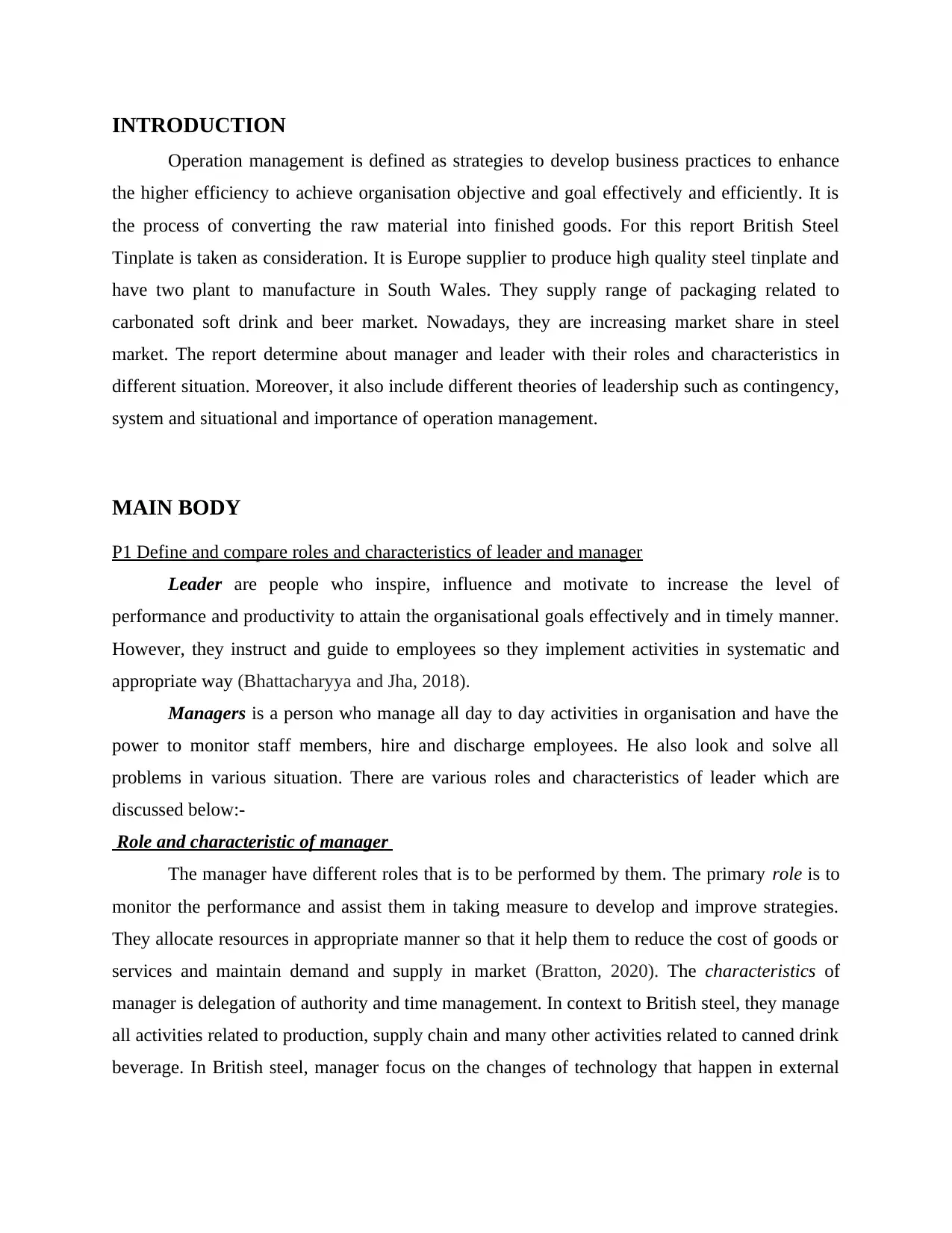
INTRODUCTION
Operation management is defined as strategies to develop business practices to enhance
the higher efficiency to achieve organisation objective and goal effectively and efficiently. It is
the process of converting the raw material into finished goods. For this report British Steel
Tinplate is taken as consideration. It is Europe supplier to produce high quality steel tinplate and
have two plant to manufacture in South Wales. They supply range of packaging related to
carbonated soft drink and beer market. Nowadays, they are increasing market share in steel
market. The report determine about manager and leader with their roles and characteristics in
different situation. Moreover, it also include different theories of leadership such as contingency,
system and situational and importance of operation management.
MAIN BODY
P1 Define and compare roles and characteristics of leader and manager
Leader are people who inspire, influence and motivate to increase the level of
performance and productivity to attain the organisational goals effectively and in timely manner.
However, they instruct and guide to employees so they implement activities in systematic and
appropriate way (Bhattacharyya and Jha, 2018).
Managers is a person who manage all day to day activities in organisation and have the
power to monitor staff members, hire and discharge employees. He also look and solve all
problems in various situation. There are various roles and characteristics of leader which are
discussed below:-
Role and characteristic of manager
The manager have different roles that is to be performed by them. The primary role is to
monitor the performance and assist them in taking measure to develop and improve strategies.
They allocate resources in appropriate manner so that it help them to reduce the cost of goods or
services and maintain demand and supply in market (Bratton, 2020). The characteristics of
manager is delegation of authority and time management. In context to British steel, they manage
all activities related to production, supply chain and many other activities related to canned drink
beverage. In British steel, manager focus on the changes of technology that happen in external
Operation management is defined as strategies to develop business practices to enhance
the higher efficiency to achieve organisation objective and goal effectively and efficiently. It is
the process of converting the raw material into finished goods. For this report British Steel
Tinplate is taken as consideration. It is Europe supplier to produce high quality steel tinplate and
have two plant to manufacture in South Wales. They supply range of packaging related to
carbonated soft drink and beer market. Nowadays, they are increasing market share in steel
market. The report determine about manager and leader with their roles and characteristics in
different situation. Moreover, it also include different theories of leadership such as contingency,
system and situational and importance of operation management.
MAIN BODY
P1 Define and compare roles and characteristics of leader and manager
Leader are people who inspire, influence and motivate to increase the level of
performance and productivity to attain the organisational goals effectively and in timely manner.
However, they instruct and guide to employees so they implement activities in systematic and
appropriate way (Bhattacharyya and Jha, 2018).
Managers is a person who manage all day to day activities in organisation and have the
power to monitor staff members, hire and discharge employees. He also look and solve all
problems in various situation. There are various roles and characteristics of leader which are
discussed below:-
Role and characteristic of manager
The manager have different roles that is to be performed by them. The primary role is to
monitor the performance and assist them in taking measure to develop and improve strategies.
They allocate resources in appropriate manner so that it help them to reduce the cost of goods or
services and maintain demand and supply in market (Bratton, 2020). The characteristics of
manager is delegation of authority and time management. In context to British steel, they manage
all activities related to production, supply chain and many other activities related to canned drink
beverage. In British steel, manager focus on the changes of technology that happen in external
Paraphrase This Document
Need a fresh take? Get an instant paraphrase of this document with our AI Paraphraser
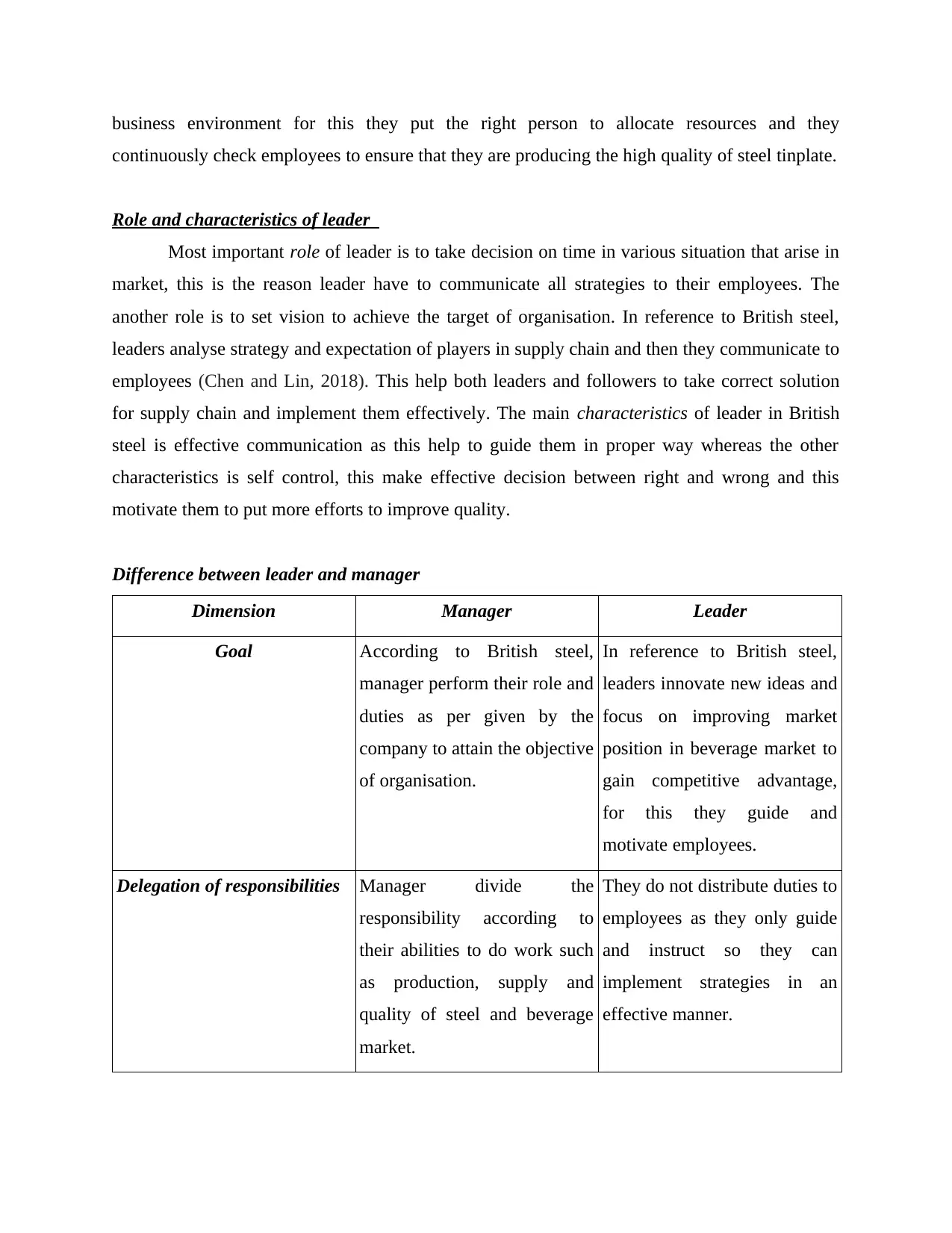
business environment for this they put the right person to allocate resources and they
continuously check employees to ensure that they are producing the high quality of steel tinplate.
Role and characteristics of leader
Most important role of leader is to take decision on time in various situation that arise in
market, this is the reason leader have to communicate all strategies to their employees. The
another role is to set vision to achieve the target of organisation. In reference to British steel,
leaders analyse strategy and expectation of players in supply chain and then they communicate to
employees (Chen and Lin, 2018). This help both leaders and followers to take correct solution
for supply chain and implement them effectively. The main characteristics of leader in British
steel is effective communication as this help to guide them in proper way whereas the other
characteristics is self control, this make effective decision between right and wrong and this
motivate them to put more efforts to improve quality.
Difference between leader and manager
Dimension Manager Leader
Goal According to British steel,
manager perform their role and
duties as per given by the
company to attain the objective
of organisation.
In reference to British steel,
leaders innovate new ideas and
focus on improving market
position in beverage market to
gain competitive advantage,
for this they guide and
motivate employees.
Delegation of responsibilities Manager divide the
responsibility according to
their abilities to do work such
as production, supply and
quality of steel and beverage
market.
They do not distribute duties to
employees as they only guide
and instruct so they can
implement strategies in an
effective manner.
continuously check employees to ensure that they are producing the high quality of steel tinplate.
Role and characteristics of leader
Most important role of leader is to take decision on time in various situation that arise in
market, this is the reason leader have to communicate all strategies to their employees. The
another role is to set vision to achieve the target of organisation. In reference to British steel,
leaders analyse strategy and expectation of players in supply chain and then they communicate to
employees (Chen and Lin, 2018). This help both leaders and followers to take correct solution
for supply chain and implement them effectively. The main characteristics of leader in British
steel is effective communication as this help to guide them in proper way whereas the other
characteristics is self control, this make effective decision between right and wrong and this
motivate them to put more efforts to improve quality.
Difference between leader and manager
Dimension Manager Leader
Goal According to British steel,
manager perform their role and
duties as per given by the
company to attain the objective
of organisation.
In reference to British steel,
leaders innovate new ideas and
focus on improving market
position in beverage market to
gain competitive advantage,
for this they guide and
motivate employees.
Delegation of responsibilities Manager divide the
responsibility according to
their abilities to do work such
as production, supply and
quality of steel and beverage
market.
They do not distribute duties to
employees as they only guide
and instruct so they can
implement strategies in an
effective manner.
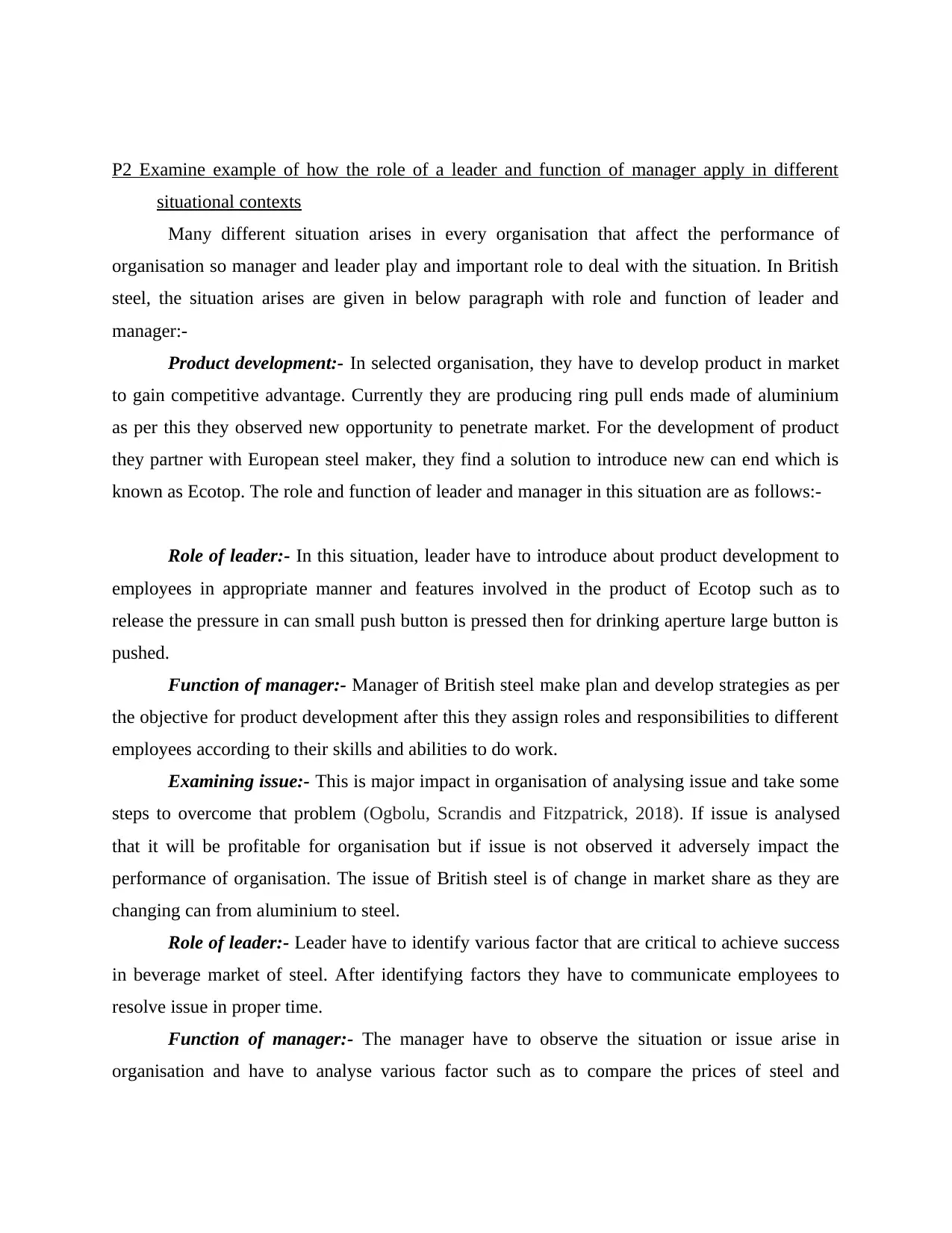
P2 Examine example of how the role of a leader and function of manager apply in different
situational contexts
Many different situation arises in every organisation that affect the performance of
organisation so manager and leader play and important role to deal with the situation. In British
steel, the situation arises are given in below paragraph with role and function of leader and
manager:-
Product development:- In selected organisation, they have to develop product in market
to gain competitive advantage. Currently they are producing ring pull ends made of aluminium
as per this they observed new opportunity to penetrate market. For the development of product
they partner with European steel maker, they find a solution to introduce new can end which is
known as Ecotop. The role and function of leader and manager in this situation are as follows:-
Role of leader:- In this situation, leader have to introduce about product development to
employees in appropriate manner and features involved in the product of Ecotop such as to
release the pressure in can small push button is pressed then for drinking aperture large button is
pushed.
Function of manager:- Manager of British steel make plan and develop strategies as per
the objective for product development after this they assign roles and responsibilities to different
employees according to their skills and abilities to do work.
Examining issue:- This is major impact in organisation of analysing issue and take some
steps to overcome that problem (Ogbolu, Scrandis and Fitzpatrick, 2018). If issue is analysed
that it will be profitable for organisation but if issue is not observed it adversely impact the
performance of organisation. The issue of British steel is of change in market share as they are
changing can from aluminium to steel.
Role of leader:- Leader have to identify various factor that are critical to achieve success
in beverage market of steel. After identifying factors they have to communicate employees to
resolve issue in proper time.
Function of manager:- The manager have to observe the situation or issue arise in
organisation and have to analyse various factor such as to compare the prices of steel and
situational contexts
Many different situation arises in every organisation that affect the performance of
organisation so manager and leader play and important role to deal with the situation. In British
steel, the situation arises are given in below paragraph with role and function of leader and
manager:-
Product development:- In selected organisation, they have to develop product in market
to gain competitive advantage. Currently they are producing ring pull ends made of aluminium
as per this they observed new opportunity to penetrate market. For the development of product
they partner with European steel maker, they find a solution to introduce new can end which is
known as Ecotop. The role and function of leader and manager in this situation are as follows:-
Role of leader:- In this situation, leader have to introduce about product development to
employees in appropriate manner and features involved in the product of Ecotop such as to
release the pressure in can small push button is pressed then for drinking aperture large button is
pushed.
Function of manager:- Manager of British steel make plan and develop strategies as per
the objective for product development after this they assign roles and responsibilities to different
employees according to their skills and abilities to do work.
Examining issue:- This is major impact in organisation of analysing issue and take some
steps to overcome that problem (Ogbolu, Scrandis and Fitzpatrick, 2018). If issue is analysed
that it will be profitable for organisation but if issue is not observed it adversely impact the
performance of organisation. The issue of British steel is of change in market share as they are
changing can from aluminium to steel.
Role of leader:- Leader have to identify various factor that are critical to achieve success
in beverage market of steel. After identifying factors they have to communicate employees to
resolve issue in proper time.
Function of manager:- The manager have to observe the situation or issue arise in
organisation and have to analyse various factor such as to compare the prices of steel and
⊘ This is a preview!⊘
Do you want full access?
Subscribe today to unlock all pages.

Trusted by 1+ million students worldwide
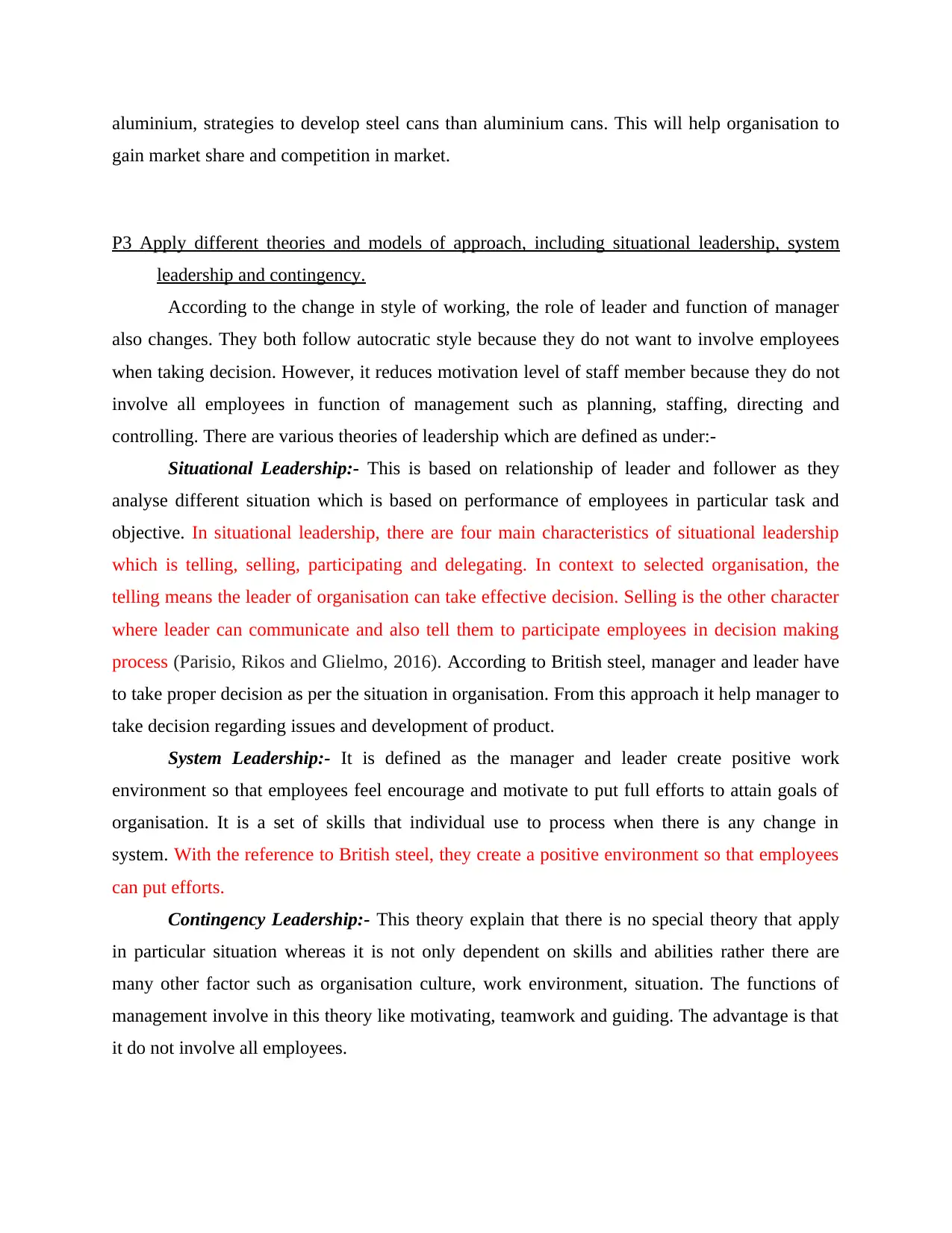
aluminium, strategies to develop steel cans than aluminium cans. This will help organisation to
gain market share and competition in market.
P3 Apply different theories and models of approach, including situational leadership, system
leadership and contingency.
According to the change in style of working, the role of leader and function of manager
also changes. They both follow autocratic style because they do not want to involve employees
when taking decision. However, it reduces motivation level of staff member because they do not
involve all employees in function of management such as planning, staffing, directing and
controlling. There are various theories of leadership which are defined as under:-
Situational Leadership:- This is based on relationship of leader and follower as they
analyse different situation which is based on performance of employees in particular task and
objective. In situational leadership, there are four main characteristics of situational leadership
which is telling, selling, participating and delegating. In context to selected organisation, the
telling means the leader of organisation can take effective decision. Selling is the other character
where leader can communicate and also tell them to participate employees in decision making
process (Parisio, Rikos and Glielmo, 2016). According to British steel, manager and leader have
to take proper decision as per the situation in organisation. From this approach it help manager to
take decision regarding issues and development of product.
System Leadership:- It is defined as the manager and leader create positive work
environment so that employees feel encourage and motivate to put full efforts to attain goals of
organisation. It is a set of skills that individual use to process when there is any change in
system. With the reference to British steel, they create a positive environment so that employees
can put efforts.
Contingency Leadership:- This theory explain that there is no special theory that apply
in particular situation whereas it is not only dependent on skills and abilities rather there are
many other factor such as organisation culture, work environment, situation. The functions of
management involve in this theory like motivating, teamwork and guiding. The advantage is that
it do not involve all employees.
gain market share and competition in market.
P3 Apply different theories and models of approach, including situational leadership, system
leadership and contingency.
According to the change in style of working, the role of leader and function of manager
also changes. They both follow autocratic style because they do not want to involve employees
when taking decision. However, it reduces motivation level of staff member because they do not
involve all employees in function of management such as planning, staffing, directing and
controlling. There are various theories of leadership which are defined as under:-
Situational Leadership:- This is based on relationship of leader and follower as they
analyse different situation which is based on performance of employees in particular task and
objective. In situational leadership, there are four main characteristics of situational leadership
which is telling, selling, participating and delegating. In context to selected organisation, the
telling means the leader of organisation can take effective decision. Selling is the other character
where leader can communicate and also tell them to participate employees in decision making
process (Parisio, Rikos and Glielmo, 2016). According to British steel, manager and leader have
to take proper decision as per the situation in organisation. From this approach it help manager to
take decision regarding issues and development of product.
System Leadership:- It is defined as the manager and leader create positive work
environment so that employees feel encourage and motivate to put full efforts to attain goals of
organisation. It is a set of skills that individual use to process when there is any change in
system. With the reference to British steel, they create a positive environment so that employees
can put efforts.
Contingency Leadership:- This theory explain that there is no special theory that apply
in particular situation whereas it is not only dependent on skills and abilities rather there are
many other factor such as organisation culture, work environment, situation. The functions of
management involve in this theory like motivating, teamwork and guiding. The advantage is that
it do not involve all employees.
Paraphrase This Document
Need a fresh take? Get an instant paraphrase of this document with our AI Paraphraser
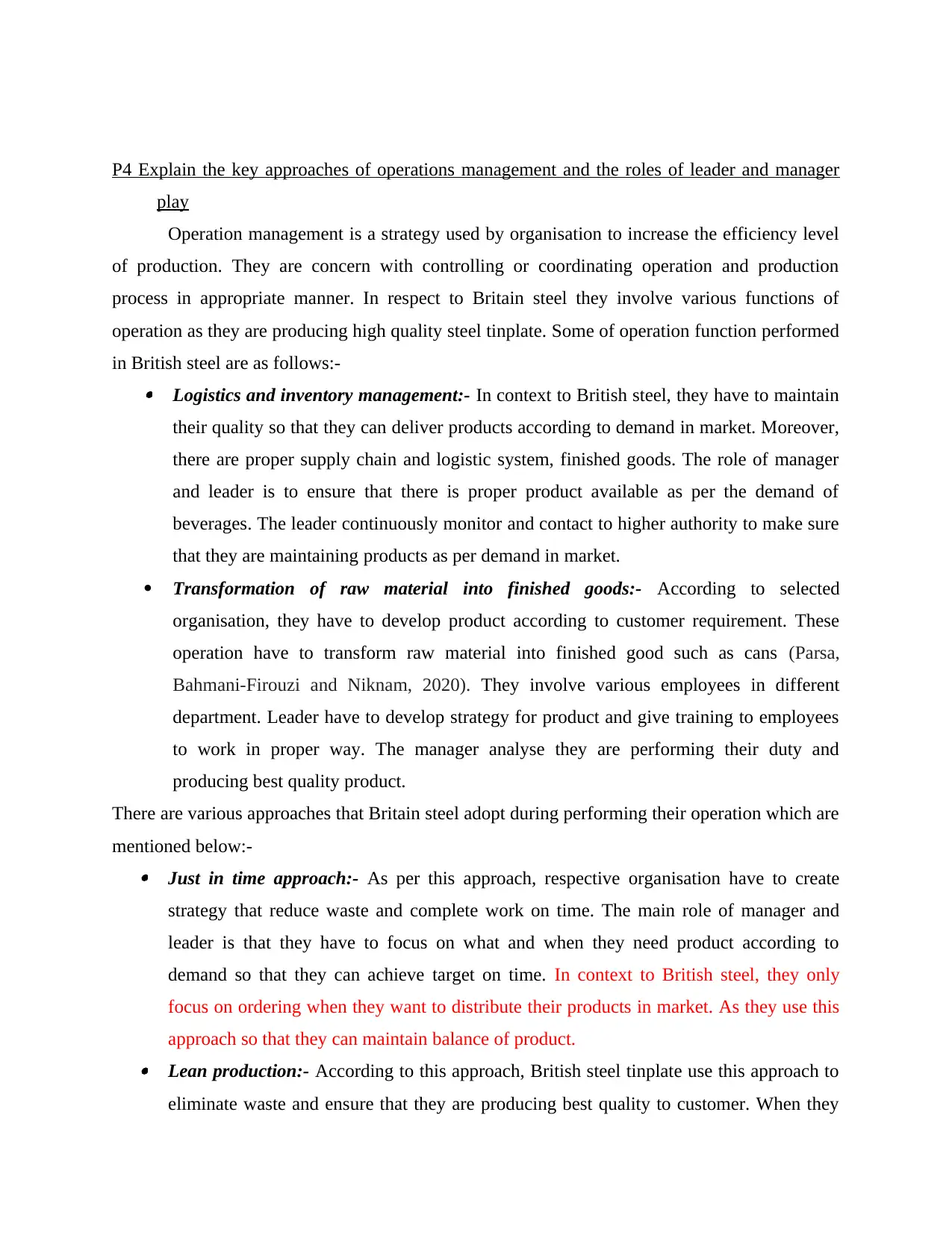
P4 Explain the key approaches of operations management and the roles of leader and manager
play
Operation management is a strategy used by organisation to increase the efficiency level
of production. They are concern with controlling or coordinating operation and production
process in appropriate manner. In respect to Britain steel they involve various functions of
operation as they are producing high quality steel tinplate. Some of operation function performed
in British steel are as follows:- Logistics and inventory management:- In context to British steel, they have to maintain
their quality so that they can deliver products according to demand in market. Moreover,
there are proper supply chain and logistic system, finished goods. The role of manager
and leader is to ensure that there is proper product available as per the demand of
beverages. The leader continuously monitor and contact to higher authority to make sure
that they are maintaining products as per demand in market.
Transformation of raw material into finished goods:- According to selected
organisation, they have to develop product according to customer requirement. These
operation have to transform raw material into finished good such as cans (Parsa,
Bahmani-Firouzi and Niknam, 2020). They involve various employees in different
department. Leader have to develop strategy for product and give training to employees
to work in proper way. The manager analyse they are performing their duty and
producing best quality product.
There are various approaches that Britain steel adopt during performing their operation which are
mentioned below:- Just in time approach:- As per this approach, respective organisation have to create
strategy that reduce waste and complete work on time. The main role of manager and
leader is that they have to focus on what and when they need product according to
demand so that they can achieve target on time. In context to British steel, they only
focus on ordering when they want to distribute their products in market. As they use this
approach so that they can maintain balance of product. Lean production:- According to this approach, British steel tinplate use this approach to
eliminate waste and ensure that they are producing best quality to customer. When they
play
Operation management is a strategy used by organisation to increase the efficiency level
of production. They are concern with controlling or coordinating operation and production
process in appropriate manner. In respect to Britain steel they involve various functions of
operation as they are producing high quality steel tinplate. Some of operation function performed
in British steel are as follows:- Logistics and inventory management:- In context to British steel, they have to maintain
their quality so that they can deliver products according to demand in market. Moreover,
there are proper supply chain and logistic system, finished goods. The role of manager
and leader is to ensure that there is proper product available as per the demand of
beverages. The leader continuously monitor and contact to higher authority to make sure
that they are maintaining products as per demand in market.
Transformation of raw material into finished goods:- According to selected
organisation, they have to develop product according to customer requirement. These
operation have to transform raw material into finished good such as cans (Parsa,
Bahmani-Firouzi and Niknam, 2020). They involve various employees in different
department. Leader have to develop strategy for product and give training to employees
to work in proper way. The manager analyse they are performing their duty and
producing best quality product.
There are various approaches that Britain steel adopt during performing their operation which are
mentioned below:- Just in time approach:- As per this approach, respective organisation have to create
strategy that reduce waste and complete work on time. The main role of manager and
leader is that they have to focus on what and when they need product according to
demand so that they can achieve target on time. In context to British steel, they only
focus on ordering when they want to distribute their products in market. As they use this
approach so that they can maintain balance of product. Lean production:- According to this approach, British steel tinplate use this approach to
eliminate waste and ensure that they are producing best quality to customer. When they
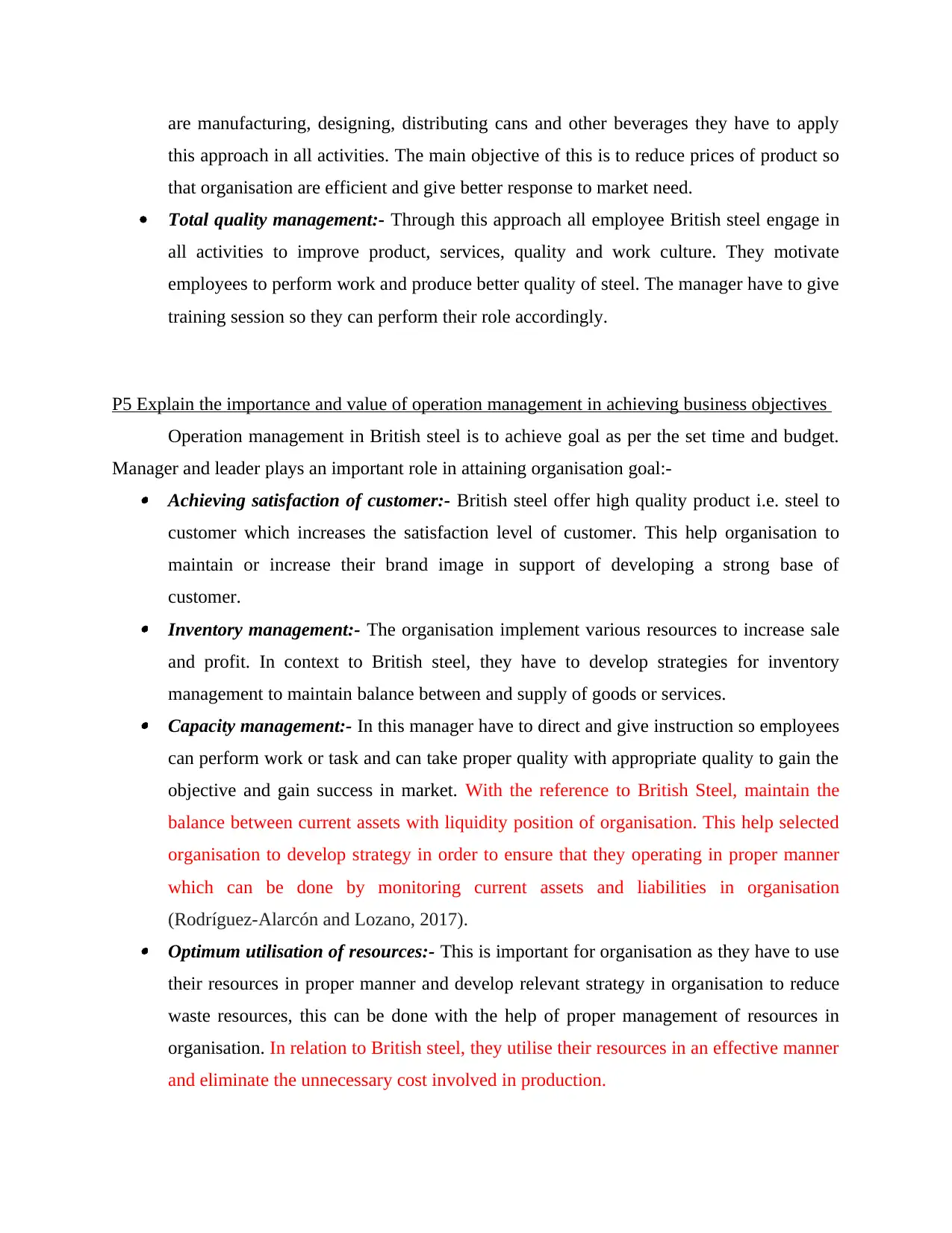
are manufacturing, designing, distributing cans and other beverages they have to apply
this approach in all activities. The main objective of this is to reduce prices of product so
that organisation are efficient and give better response to market need.
Total quality management:- Through this approach all employee British steel engage in
all activities to improve product, services, quality and work culture. They motivate
employees to perform work and produce better quality of steel. The manager have to give
training session so they can perform their role accordingly.
P5 Explain the importance and value of operation management in achieving business objectives
Operation management in British steel is to achieve goal as per the set time and budget.
Manager and leader plays an important role in attaining organisation goal:- Achieving satisfaction of customer:- British steel offer high quality product i.e. steel to
customer which increases the satisfaction level of customer. This help organisation to
maintain or increase their brand image in support of developing a strong base of
customer. Inventory management:- The organisation implement various resources to increase sale
and profit. In context to British steel, they have to develop strategies for inventory
management to maintain balance between and supply of goods or services. Capacity management:- In this manager have to direct and give instruction so employees
can perform work or task and can take proper quality with appropriate quality to gain the
objective and gain success in market. With the reference to British Steel, maintain the
balance between current assets with liquidity position of organisation. This help selected
organisation to develop strategy in order to ensure that they operating in proper manner
which can be done by monitoring current assets and liabilities in organisation
(Rodríguez-Alarcón and Lozano, 2017). Optimum utilisation of resources:- This is important for organisation as they have to use
their resources in proper manner and develop relevant strategy in organisation to reduce
waste resources, this can be done with the help of proper management of resources in
organisation. In relation to British steel, they utilise their resources in an effective manner
and eliminate the unnecessary cost involved in production.
this approach in all activities. The main objective of this is to reduce prices of product so
that organisation are efficient and give better response to market need.
Total quality management:- Through this approach all employee British steel engage in
all activities to improve product, services, quality and work culture. They motivate
employees to perform work and produce better quality of steel. The manager have to give
training session so they can perform their role accordingly.
P5 Explain the importance and value of operation management in achieving business objectives
Operation management in British steel is to achieve goal as per the set time and budget.
Manager and leader plays an important role in attaining organisation goal:- Achieving satisfaction of customer:- British steel offer high quality product i.e. steel to
customer which increases the satisfaction level of customer. This help organisation to
maintain or increase their brand image in support of developing a strong base of
customer. Inventory management:- The organisation implement various resources to increase sale
and profit. In context to British steel, they have to develop strategies for inventory
management to maintain balance between and supply of goods or services. Capacity management:- In this manager have to direct and give instruction so employees
can perform work or task and can take proper quality with appropriate quality to gain the
objective and gain success in market. With the reference to British Steel, maintain the
balance between current assets with liquidity position of organisation. This help selected
organisation to develop strategy in order to ensure that they operating in proper manner
which can be done by monitoring current assets and liabilities in organisation
(Rodríguez-Alarcón and Lozano, 2017). Optimum utilisation of resources:- This is important for organisation as they have to use
their resources in proper manner and develop relevant strategy in organisation to reduce
waste resources, this can be done with the help of proper management of resources in
organisation. In relation to British steel, they utilise their resources in an effective manner
and eliminate the unnecessary cost involved in production.
⊘ This is a preview!⊘
Do you want full access?
Subscribe today to unlock all pages.

Trusted by 1+ million students worldwide
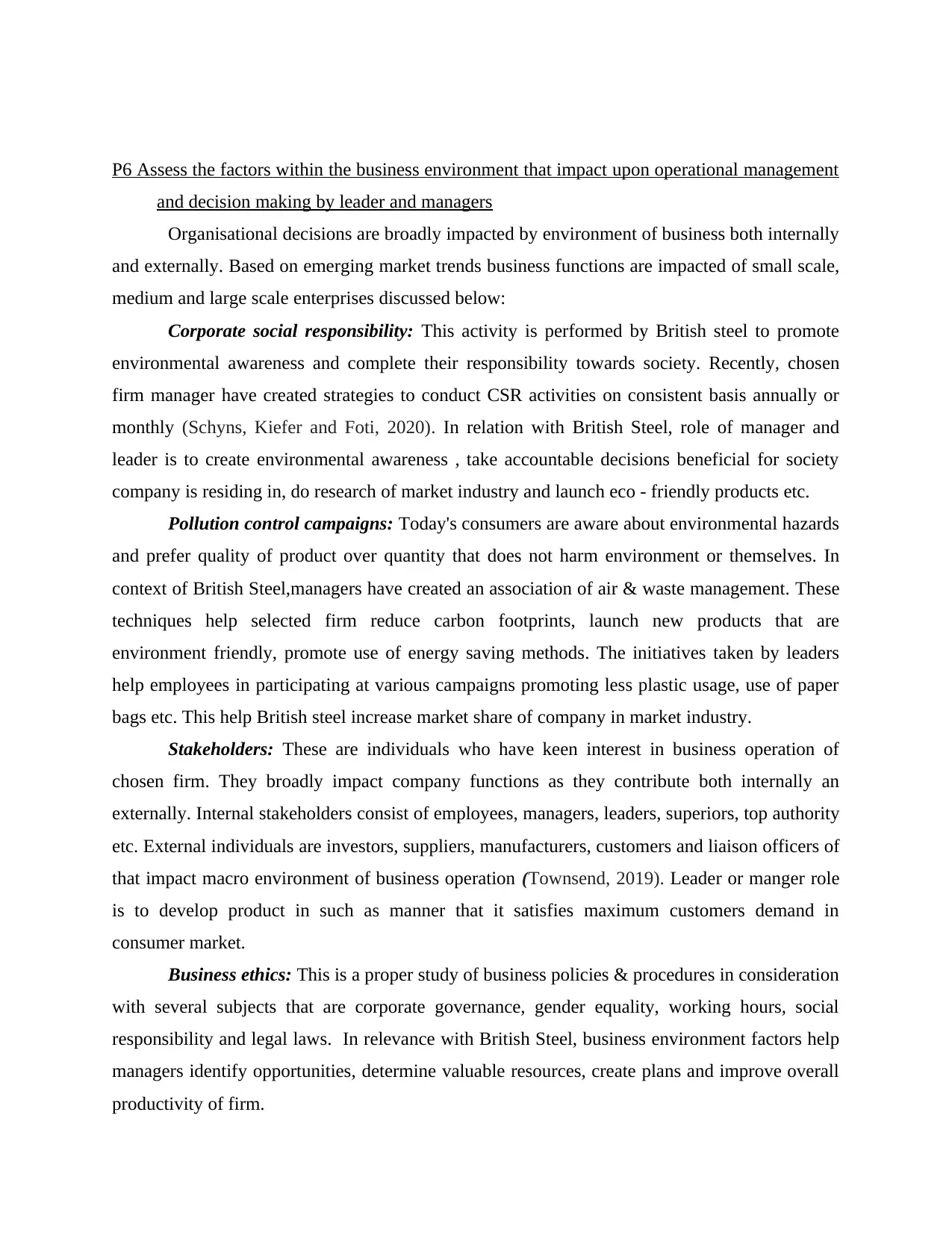
P6 Assess the factors within the business environment that impact upon operational management
and decision making by leader and managers
Organisational decisions are broadly impacted by environment of business both internally
and externally. Based on emerging market trends business functions are impacted of small scale,
medium and large scale enterprises discussed below:
Corporate social responsibility: This activity is performed by British steel to promote
environmental awareness and complete their responsibility towards society. Recently, chosen
firm manager have created strategies to conduct CSR activities on consistent basis annually or
monthly (Schyns, Kiefer and Foti, 2020). In relation with British Steel, role of manager and
leader is to create environmental awareness , take accountable decisions beneficial for society
company is residing in, do research of market industry and launch eco - friendly products etc.
Pollution control campaigns: Today's consumers are aware about environmental hazards
and prefer quality of product over quantity that does not harm environment or themselves. In
context of British Steel,managers have created an association of air & waste management. These
techniques help selected firm reduce carbon footprints, launch new products that are
environment friendly, promote use of energy saving methods. The initiatives taken by leaders
help employees in participating at various campaigns promoting less plastic usage, use of paper
bags etc. This help British steel increase market share of company in market industry.
Stakeholders: These are individuals who have keen interest in business operation of
chosen firm. They broadly impact company functions as they contribute both internally an
externally. Internal stakeholders consist of employees, managers, leaders, superiors, top authority
etc. External individuals are investors, suppliers, manufacturers, customers and liaison officers of
that impact macro environment of business operation (Townsend, 2019). Leader or manger role
is to develop product in such as manner that it satisfies maximum customers demand in
consumer market.
Business ethics: This is a proper study of business policies & procedures in consideration
with several subjects that are corporate governance, gender equality, working hours, social
responsibility and legal laws. In relevance with British Steel, business environment factors help
managers identify opportunities, determine valuable resources, create plans and improve overall
productivity of firm.
and decision making by leader and managers
Organisational decisions are broadly impacted by environment of business both internally
and externally. Based on emerging market trends business functions are impacted of small scale,
medium and large scale enterprises discussed below:
Corporate social responsibility: This activity is performed by British steel to promote
environmental awareness and complete their responsibility towards society. Recently, chosen
firm manager have created strategies to conduct CSR activities on consistent basis annually or
monthly (Schyns, Kiefer and Foti, 2020). In relation with British Steel, role of manager and
leader is to create environmental awareness , take accountable decisions beneficial for society
company is residing in, do research of market industry and launch eco - friendly products etc.
Pollution control campaigns: Today's consumers are aware about environmental hazards
and prefer quality of product over quantity that does not harm environment or themselves. In
context of British Steel,managers have created an association of air & waste management. These
techniques help selected firm reduce carbon footprints, launch new products that are
environment friendly, promote use of energy saving methods. The initiatives taken by leaders
help employees in participating at various campaigns promoting less plastic usage, use of paper
bags etc. This help British steel increase market share of company in market industry.
Stakeholders: These are individuals who have keen interest in business operation of
chosen firm. They broadly impact company functions as they contribute both internally an
externally. Internal stakeholders consist of employees, managers, leaders, superiors, top authority
etc. External individuals are investors, suppliers, manufacturers, customers and liaison officers of
that impact macro environment of business operation (Townsend, 2019). Leader or manger role
is to develop product in such as manner that it satisfies maximum customers demand in
consumer market.
Business ethics: This is a proper study of business policies & procedures in consideration
with several subjects that are corporate governance, gender equality, working hours, social
responsibility and legal laws. In relevance with British Steel, business environment factors help
managers identify opportunities, determine valuable resources, create plans and improve overall
productivity of firm.
Paraphrase This Document
Need a fresh take? Get an instant paraphrase of this document with our AI Paraphraser
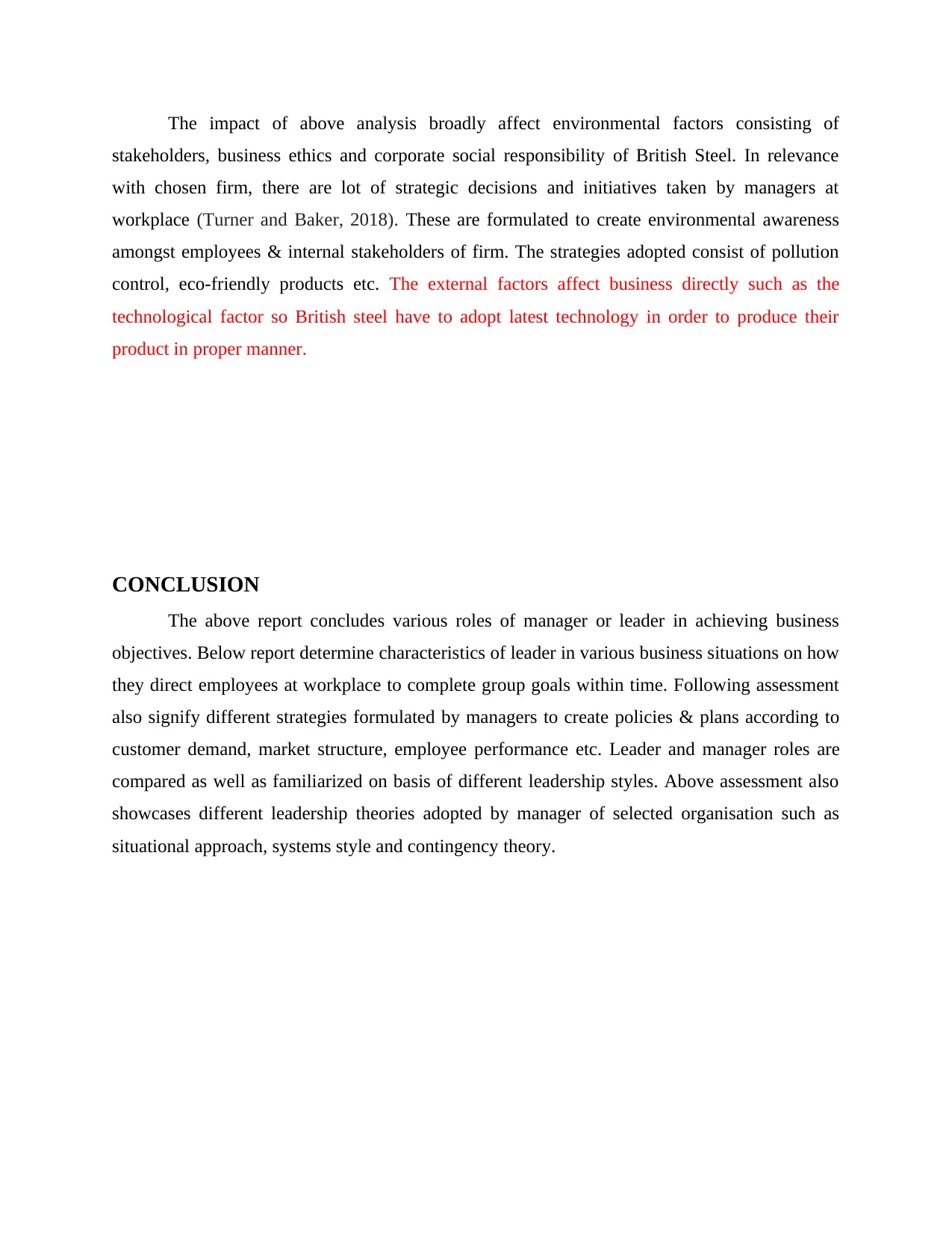
The impact of above analysis broadly affect environmental factors consisting of
stakeholders, business ethics and corporate social responsibility of British Steel. In relevance
with chosen firm, there are lot of strategic decisions and initiatives taken by managers at
workplace (Turner and Baker, 2018). These are formulated to create environmental awareness
amongst employees & internal stakeholders of firm. The strategies adopted consist of pollution
control, eco-friendly products etc. The external factors affect business directly such as the
technological factor so British steel have to adopt latest technology in order to produce their
product in proper manner.
CONCLUSION
The above report concludes various roles of manager or leader in achieving business
objectives. Below report determine characteristics of leader in various business situations on how
they direct employees at workplace to complete group goals within time. Following assessment
also signify different strategies formulated by managers to create policies & plans according to
customer demand, market structure, employee performance etc. Leader and manager roles are
compared as well as familiarized on basis of different leadership styles. Above assessment also
showcases different leadership theories adopted by manager of selected organisation such as
situational approach, systems style and contingency theory.
stakeholders, business ethics and corporate social responsibility of British Steel. In relevance
with chosen firm, there are lot of strategic decisions and initiatives taken by managers at
workplace (Turner and Baker, 2018). These are formulated to create environmental awareness
amongst employees & internal stakeholders of firm. The strategies adopted consist of pollution
control, eco-friendly products etc. The external factors affect business directly such as the
technological factor so British steel have to adopt latest technology in order to produce their
product in proper manner.
CONCLUSION
The above report concludes various roles of manager or leader in achieving business
objectives. Below report determine characteristics of leader in various business situations on how
they direct employees at workplace to complete group goals within time. Following assessment
also signify different strategies formulated by managers to create policies & plans according to
customer demand, market structure, employee performance etc. Leader and manager roles are
compared as well as familiarized on basis of different leadership styles. Above assessment also
showcases different leadership theories adopted by manager of selected organisation such as
situational approach, systems style and contingency theory.
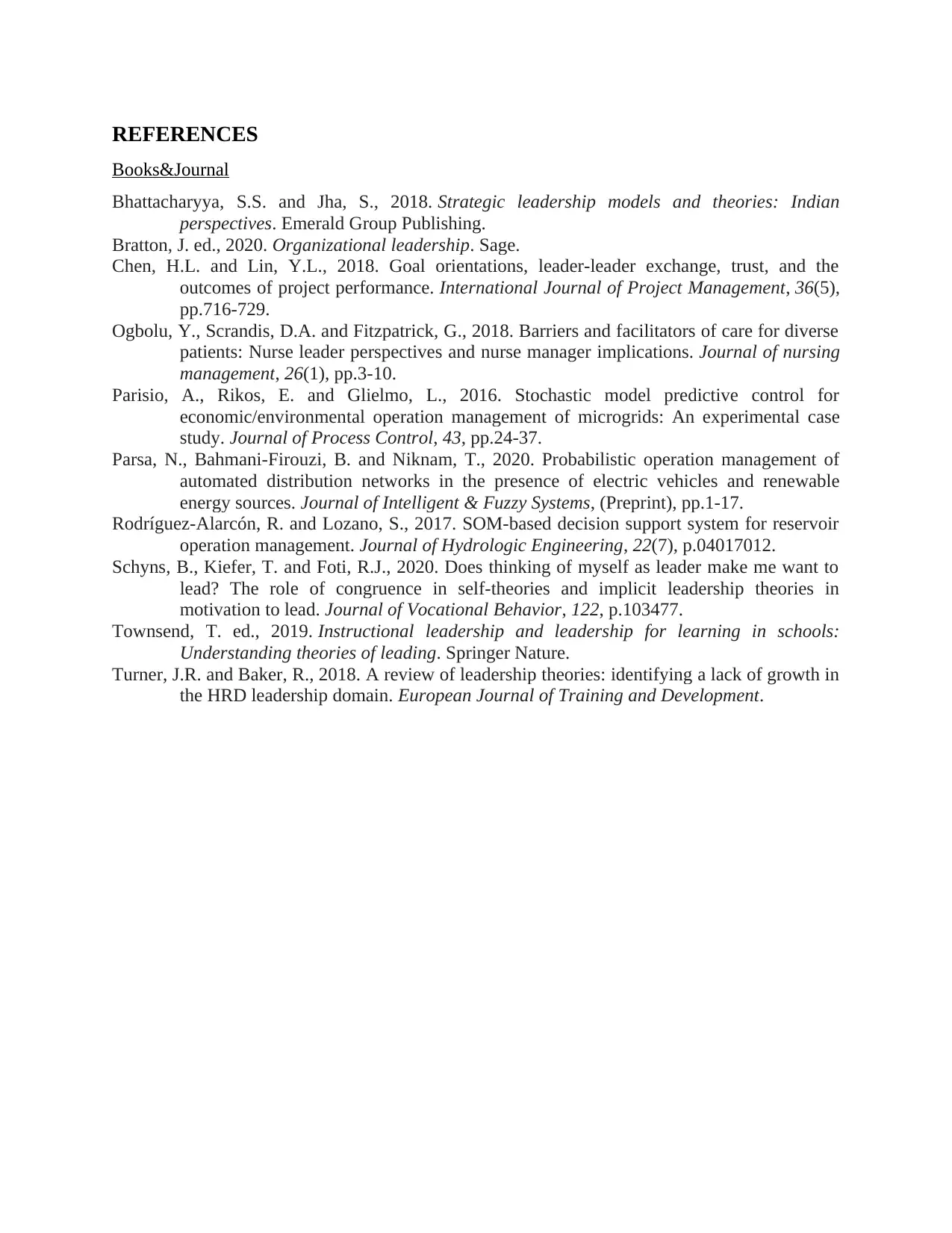
REFERENCES
Books&Journal
Bhattacharyya, S.S. and Jha, S., 2018. Strategic leadership models and theories: Indian
perspectives. Emerald Group Publishing.
Bratton, J. ed., 2020. Organizational leadership. Sage.
Chen, H.L. and Lin, Y.L., 2018. Goal orientations, leader-leader exchange, trust, and the
outcomes of project performance. International Journal of Project Management, 36(5),
pp.716-729.
Ogbolu, Y., Scrandis, D.A. and Fitzpatrick, G., 2018. Barriers and facilitators of care for diverse
patients: Nurse leader perspectives and nurse manager implications. Journal of nursing
management, 26(1), pp.3-10.
Parisio, A., Rikos, E. and Glielmo, L., 2016. Stochastic model predictive control for
economic/environmental operation management of microgrids: An experimental case
study. Journal of Process Control, 43, pp.24-37.
Parsa, N., Bahmani-Firouzi, B. and Niknam, T., 2020. Probabilistic operation management of
automated distribution networks in the presence of electric vehicles and renewable
energy sources. Journal of Intelligent & Fuzzy Systems, (Preprint), pp.1-17.
Rodríguez-Alarcón, R. and Lozano, S., 2017. SOM-based decision support system for reservoir
operation management. Journal of Hydrologic Engineering, 22(7), p.04017012.
Schyns, B., Kiefer, T. and Foti, R.J., 2020. Does thinking of myself as leader make me want to
lead? The role of congruence in self-theories and implicit leadership theories in
motivation to lead. Journal of Vocational Behavior, 122, p.103477.
Townsend, T. ed., 2019. Instructional leadership and leadership for learning in schools:
Understanding theories of leading. Springer Nature.
Turner, J.R. and Baker, R., 2018. A review of leadership theories: identifying a lack of growth in
the HRD leadership domain. European Journal of Training and Development.
Books&Journal
Bhattacharyya, S.S. and Jha, S., 2018. Strategic leadership models and theories: Indian
perspectives. Emerald Group Publishing.
Bratton, J. ed., 2020. Organizational leadership. Sage.
Chen, H.L. and Lin, Y.L., 2018. Goal orientations, leader-leader exchange, trust, and the
outcomes of project performance. International Journal of Project Management, 36(5),
pp.716-729.
Ogbolu, Y., Scrandis, D.A. and Fitzpatrick, G., 2018. Barriers and facilitators of care for diverse
patients: Nurse leader perspectives and nurse manager implications. Journal of nursing
management, 26(1), pp.3-10.
Parisio, A., Rikos, E. and Glielmo, L., 2016. Stochastic model predictive control for
economic/environmental operation management of microgrids: An experimental case
study. Journal of Process Control, 43, pp.24-37.
Parsa, N., Bahmani-Firouzi, B. and Niknam, T., 2020. Probabilistic operation management of
automated distribution networks in the presence of electric vehicles and renewable
energy sources. Journal of Intelligent & Fuzzy Systems, (Preprint), pp.1-17.
Rodríguez-Alarcón, R. and Lozano, S., 2017. SOM-based decision support system for reservoir
operation management. Journal of Hydrologic Engineering, 22(7), p.04017012.
Schyns, B., Kiefer, T. and Foti, R.J., 2020. Does thinking of myself as leader make me want to
lead? The role of congruence in self-theories and implicit leadership theories in
motivation to lead. Journal of Vocational Behavior, 122, p.103477.
Townsend, T. ed., 2019. Instructional leadership and leadership for learning in schools:
Understanding theories of leading. Springer Nature.
Turner, J.R. and Baker, R., 2018. A review of leadership theories: identifying a lack of growth in
the HRD leadership domain. European Journal of Training and Development.
⊘ This is a preview!⊘
Do you want full access?
Subscribe today to unlock all pages.

Trusted by 1+ million students worldwide
1 out of 12
Related Documents
Your All-in-One AI-Powered Toolkit for Academic Success.
+13062052269
info@desklib.com
Available 24*7 on WhatsApp / Email
![[object Object]](/_next/static/media/star-bottom.7253800d.svg)
Unlock your academic potential
Copyright © 2020–2025 A2Z Services. All Rights Reserved. Developed and managed by ZUCOL.





